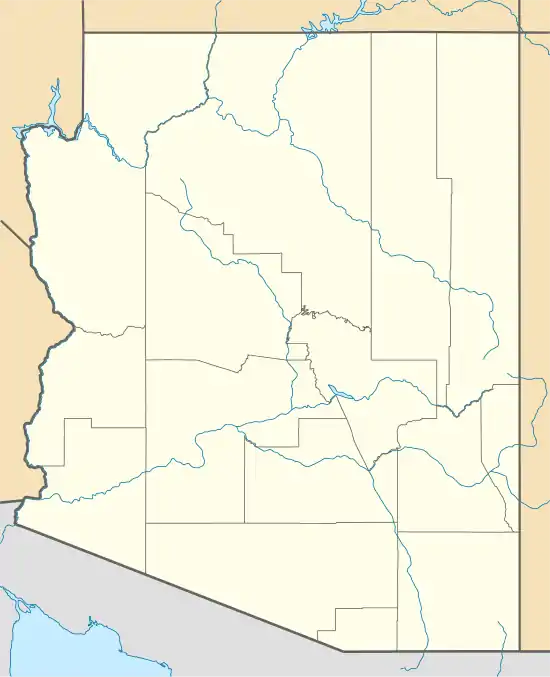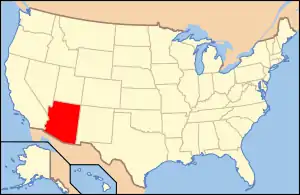Carver High School (Phoenix, Arizona)
Carver High School (Full name George Washington Carver High School,[2] formerly known as Phoenix Union Colored High School[2]) was a segregated high school in Phoenix, Arizona.
| George Washington Carver High School | |
|---|---|
Phoenix Union Colored High School | |
  | |
| Location | 415 E. Grant St., Phoenix, Arizona |
| Coordinates | 33.440557°N 112.068160°W |
| Area | 4.9 acres (2.0 ha) |
| Built | 1926 |
| Architect | Pierson & Johnson |
| Architectural style | 20th Century Commercial |
| NRHP reference No. | 91000543[1] |
| Added to NRHP | May 2, 1991 |
| Location | |

| |
The school's building was the only one ever built exclusively to serve African American high school students in Arizona.[3]
Historic site
The school was built on the site of a former four-acre landfill, and was surrounded by warehouses.[2] Students who attended classes at the school said the school was built in between the two African American communities south of Downtown Phoenix at the time, and was strategically placed to serve as many African American students as possible.[2]
The site of the school was purchased for $10,500 in 1925.[4] There were initial protests to the location, due to its proximity to industrial and contaminated area.[5] Even the school board admitted at the time that the location will require "watchmen to protect children going to and from school", and that physicians admit the location is a "hot bed and nucleus of virulent contagious diseases".[4]
The school was built by general contractors Pierson & Johnson, who submitted a bid of $110,000.[4] The school was remodeled and enlarged in 1948, which included the building of new shop facilities, as well as a 1,000 seat stadium.[4]
After the school's closure, school grounds were converted into office and storage space.[2][5][4]
The school building, along with the land it sits on, was listed on the National Register of Historic Places in 1991.[1][6]
The school grounds were purchased by the Phoenix Monarchs Alumni Association, a group of Carver High alumni, in 1996.[7] The school's alumni collected $200,000, including a grant by the city's Parks and Recreation Board, to buy the building.[8] Work began in 2001 to convert the site into a community cultural center and art gallery, in a partnership with the City of Phoenix which involved several million dollars of Phoenix bond funding, along with other grants.[5][7]
A report by Phoenix NPR station KJZZ noted that the school campus could have been demolished, had efforts to save it fail to materialize.[2]
Currently, the former school's main building and shop building still exist.,[4] While the school's football field has been paved over,[8] the nearby grandstand still exists.[4]
The campus was added to the Phoenix Historic Property Register, after the Phoenix City Council approved the addition in March 2017.[9][10] This will protect the school campus from demolition, as well as making the site eligible for city incentives to help with rehabilitation.[9]
School
| George Washington Carver High School | |
|---|---|
 | |
| Location | |

| |
| Information | |
| Former name | Phoenix Union Colored High School (1926-1943) |
| Type | Public, segregated |
| Established | 13 September 1926[11] |
| Closed | 1954[11] |
| Enrollment | 406 (1954[12]) |
| Mascot | Monarchs[12] |
In 1909, before Arizona gained statehood, the Arizona territory passed a law that said segregation in elementary schools was legal when there were more than 8 African Americans. However, segregation of high schools was never required under Arizona law.[5][13]
During the 1920s and late 1910s, African American students were segregated in the cellar of Phoenix Union High School, as in many other schools in Arizona at the time.
Carver High had its roots in the "Department for Colored Students" that was established at a rear room of Phoenix Union High School's Commercial Building in 1918, with one teacher.[4] The school's African American students were then housed in two small cottages that was separated from the PUHS campus by an irrigation ditch,[4] and later housed the students at a house on 9th Street and Jefferson.[4]
The school opened in 1926, costing the district $150,000.[11] According to Phoenix Union High School District, the school was built to accommodate the district's African American population.[11] Many contemporary sources, however, state that the school was built to segregate African American high school students.[2][5][14] Another possible reason may be that the two races broke out into frequent fights at school. The school was the only legally segregated high school in Phoenix,[2] and it opened following anti-African American sentiments that increased after World War I.[5]
This new school was dedicated on September 10, 1926 in a huge ceremony. Almost 350 people packed into the auditorium of the new Phoenix Union Colored High School. The school would have more teachers, more equipment, and sports teams. Most importantly, the school had new AC System. However, the sports teams were not allowed to play with White sports teams, the games were between Mexican and Native American students, who also went to segregated schools.
The school's final location opened for classes on September 14th.[4]
The school was renamed after George Washington Carver in 1943 with the hiring of W. A. Robinson, an accomplished educator,[2] and it was closed in 1954,[11] a year after a judge at the Maricopa County Superior Court ruled school segregation in Phoenix high schools was unconstitutional, in the case Phillips vs. Phoenix Union High Schools and Junior College District.[5][15]
To this day, Phoenix Union High School District's website makes few references to the school's segregated past, merely stating that the school closed, following integration.[11]
Education
The school was known for its strong academics and athletic programs, despite having deficient resources, like microscopes.[5]
In 1943, after W. A. Robinson became principal, many students and teachers recall that he recruited teachers from all across the country.
Therefore, many of the recruited teachers there held Master's degrees, at a time when few did.[2]
In popular culture
A basketball game between the team at Carver High and a team composed mostly of Mexican and Mexican American teenagers at Miami High School in Miami, Arizona was the subject of the play The Mighty Vandals, which was shown at the Herberger Theater in Phoenix and Miami High School.[2][16]
Integration
In 1950, two African Americans, Hayzel Daniels and Carl Simms, were elected to the Arizona state legislature. To end “separate-but-equal” once and for all, Daniels and two other White attorneys, with the help of several Arizonan civil rights organizations, filed a lawsuit on June 9, 1952. They argued that,
"The high schools of Phoenix, Maricopa, Arizona, set apart for White students…are superior to the schools set apart for the African race. Segregation of African pupils by race has a detrimental effect on such African pupils, imparting to them a stigma of inferiority, retarding their educational and mental development, and depriving them of some of the benefits they would receive in an integrated school system.” [17]
On February 8, 1953, Judge Struckmeyer ruled that the 1909 segregation law was unconstitutional, and that all high schools would have to integrate as soon as possible. This was more than a year before the rest of the country integrated.[17]
After that, Arizonan activist organizations set out to integrate elementary schools as well.
So on May 5th, 1954, Superior Court Judge Charles Bernstein ruled in Heard v. Davis that all elementary school segregation in Arizona violated the 14th amendment. It was ruled 4 days before the rest of the country integrated.[18]
In the national desegregation case of Brown v. Board of Education, the Supreme Court cited these two Arizona cases in their arguments to integrate. Brown v. Board of Education was an important turning point of the Civil Rights movement. This case was not only the first step toward desegregation, but it was also the first step to breaking other barriers of discrimination for other minorities as well.
Notable people
- Charles "Chuck" Harrison, Industrial designer[19]
- Ira O’Neal, a member of the Tuskegee Airmen.[20]
- Coy Payne, former mayor of Chandler, Arizona and first African-American to be elected as mayor in Arizona.[20]
- William Byron Rumford, pharmacist, politician, first African American elected to a state public office in Northern California[21]
- Ed Shivers, a member of the Tuskegee Airmen.[20]
See also
- Phoenix Union High School, also NRHP-listed
- List of museums focused on African Americans
References
- "National Register Information System". National Register of Historic Places. National Park Service. March 13, 2009.
- Arroyo Rodriguez, Nadine (18 October 2013). "Did You Know: George Washington Carver High School Has Rich History". KJZZ-FM. Retrieved 30 November 2017.
- African American Historic Places. John Wiley & Sons, Inc. 1994. p. 108. ISBN 9780471143451. Retrieved 30 November 2017.
- "Staff Report: Z-72-16-8" (PDF). City of Phoenix. 10 November 2016. Retrieved 30 November 2017.
- Goth, Brenna (25 January 2017). "Phoenix school that was segregated envisioned as 'a place you can talk the truth'". The Arizona Republic. Retrieved 30 November 2017.
- "History". George Washington Carver Museum and Cultural Center. Retrieved 30 November 2017.
- Sextin, Connie (29 February 2008). "Carver museum embodies struggles, triumphs of city's Blacks". The Arizona Republic. Retrieved 30 November 2017.
Former Phoenix City Councilman Calvin Goode, a Carver alumnus, helped to bring about the museum.
- Sterling, Terry Greene (30 May 1996). "Old-School Ways". Phoenix New Times. Retrieved 18 January 2018.
- Estes, Christina (17 March 2017). "Phoenix School Built For African-Americans Gains Historic Landmark Status". KJZZ-FM. Retrieved 3 December 2017.
- "Phoenix Historic Property Register" (PDF). City of Phoenix Planning & Development Department. May 2017. p. 4. Retrieved 26 December 2017.
- "District Information / History". Phoenix Union High School District. Retrieved 30 November 2017.
- "Arizona High School Enrollment Figures (1912-2005)" (PDF). aiaonline.org.
- Finn, Elizabeth (July 1998). "The Struggle for Civil Rights in Arizona". State Bar of Arizona. Archived from the original on 4 March 2016. Retrieved 3 December 2017.
At mid-century, state law mandated segregation in the elementary schools but made it optional in the high schools.
- "Historic Segregated High School in Downtown Phoenix is in Desperate Need of Repair". KASW-TV. 19 January 2017. Retrieved 14 January 2018.
- "Frederick C. Struckmeyer". Arizona Legal Legacies Project. Retrieved 30 November 2017.
- Gross, Linda (17 October 2013). "The play "The Mighty Vandals" recalls the '51 Championship, and comes to Miami Oct. 26-27". Globe Miami Times. Retrieved 30 November 2017.
- "The Judicial Branch of Arizona in Maricopa County -". superiorcourt.maricopa.gov. Retrieved 2020-12-01.
- "The Judicial Branch of Arizona in Maricopa County -". superiorcourt.maricopa.gov. Retrieved 2020-12-01.
- "Harrison, Charles A. "Chuck" (1931– )". Retrieved 23 November 2018.
- Johnson, Weldon B. (February 5, 2020). "AZ's only high school for black students is now a Phoenix museum that tells their stories". The Arizona Republic (via USA Today). Retrieved May 18, 2020.
- "Rumford, William Byron, Sr. (1908-1986)". Retrieved 23 November 2018.

